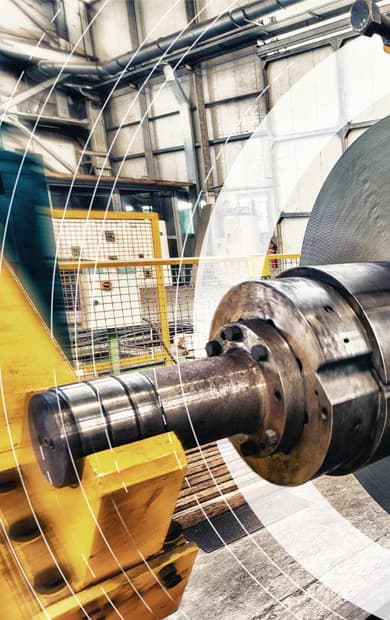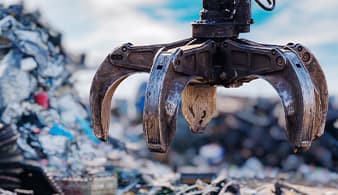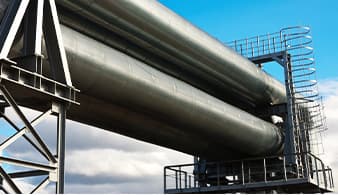Overview
Argus delivers trusted price data and market intelligence to help you understand the drivers behind primary and secondary metal markets. Our service differentiates with in-depth market commentary, analysis and news on ferrous and non-ferrous metals at the heart of commercial trade and industrial manufacturing.
The global metals supply chain uses Argus metals commodity data as a reference in physical supply and derivative contracts, for mark-to-market purposes, as a value indicator for tax assessments, for risk management, and in strategic analysis and planning.
Argus delivers four core products within its metals portfolio: Argus Steelmaking Raw Materials, Argus Non-Ferrous Markets, Argus Scrap Markets and Argus Battery Materials. Each offering includes access to Argus Metals – your definitive metals platform.
Metals market coverage
Argus is a leading independent provider of market intelligence to the global energy and commodity markets. Our price assessments and market intelligence are available for all major metals markets across the globe. Explore the coverage most relevant to your business:
Latest metals news
Browse the latest market moving news on the global metals industry.
Mexico central bank cuts target rate to 7pc
Mexico central bank cuts target rate to 7pc
Mexico City, 19 December (Argus) — Mexico's central bank cut its benchmark interest rate by 25 basis points to 7pc, its lowest level since June 2022, maintaining a slower pace in the easing cycle on inflation concerns. The decision marked the eighth rate cut this year and the fourth quarter-point reduction following four consecutive half-point cuts. This year's cuts follow five quarter-point cuts in 2024 from a cyclical peak of 11.25pc in March. The board approved the cut in a 4-1 vote, with deputy governor Jonathan Heath dissenting in favor of holding the rate at 7.25pc. Heath has been the lone dissenter in the past five decisions, consistently urging greater caution. The central bank said the decision reflected "the behavior of the exchange rate, the weakness of economic activity and the possible impact of changes in global trade policies," repeating language used in its last four statements. Gabriela Siller, chief economist at Banco Base, pointed to a "significant change" in the bank's forward guidance, noting a shift toward a less dovish tone. The board said it "will consider when to make further adjustments" to the policy rate, replacing the "will consider cutting" language used in November. Mexican bank Banorte also said the central bank struck a less dovish tone, pointing to a change in its forward guidance. Annual inflation rose to 3.8pc in November from 3.57pc in October, according to statistics agency Inegi. Core inflation, which excludes volatile food and energy prices, accelerated to 4.43pc from 4.28pc. The central bank now sees headline inflation ending 2025 at 3.7pc, up from 3.5pc in its November forecast, while core inflation is projected at 4.3pc, revised from 4.1pc. It also raised its headline and core forecasts for the first two quarters of 2026, while maintaining that both will converge to its 3pc target by the third quarter. The bank said the revisions mainly reflect a "more gradual-than-expected" easing in services inflation, along with a smaller contribution from accelerating consumer goods prices. The board also addressed recent tax reforms, which it expects will have a temporary and not necessarily proportional impact on prices, adding it will update its forecasts as it conducts a comprehensive assessment of the revised tax code's effects. By James Young Send comments and request more information at feedback@argusmedia.com Copyright © 2025. Argus Media group . All rights reserved.
Viewpoint: Al industry faces structural Europe decline
Viewpoint: Al industry faces structural Europe decline
London, 19 December (Argus) — The European aluminium industry has heard some highly optimistic forecasts for prices and demand recovery in 2026 at a series of late-year industry events that started with London Metal Exchange (LME) Week in October. But that optimism rests on assumptions of a sharp recovery in demand for which there is no real evidence, and concerns are growing that the extended downturn in European manufacturing represents a more structural shift in global industrial power. Some industry analysts forecast in October that LME aluminium prices could reach $3,000/t by the end of 2025, and even threaten the $4,000/t mark at some point in 2026. The forecasts assumed a continuation of the supply tightness that has become a major driver of global aluminium markets in 2025 as Chinese output has neared its production cap of 45mn t/yr and production growth has also slowed elsewhere, as many regions focus away from capacity expansion. But the bullish price projection was also supported by expectations of a recovery in demand from manufacturing industries following a lengthy period of contraction, particularly in Europe. With demand levels for aluminium-intensive goods currently well below trend, those analysts foresee a much better demand outlook for next year. But the reality may be that the downturn in aluminium demand in Europe is more structural, and as a result there is no reason to expect a significant improvement just because it is due in an historical context. The automotive sector is a particularly potent example. After a steep fall in manufacturing rates in 2020 because of the Covid-19 pandemic, Europe's automotive sector has yet to recover to 2019 levels. Production even fell back in 2024 by more than 6pc from the previous year on strong competition from China and lower consumer spending because of high inflation and rising interest rates. European car production fell further in the first half of 2025, by 2.6pc on the year as stricter emissions targets, high energy costs and US import tariffs hit output. Even relief in the form of falling interest rates or more affordable energy would not be enough to bring European car manufacturing back to 2019 levels. As European output has fallen, other countries have risen to take its place. Global car production grew by 3.5pc in the first half of this year, with Chinese output jumping by 12pc on the back of climbing electric vehicle (EV) sales, thanks to policy support and, crucially, rising exports. As Europe once led the world in internal combustion engine markets, so China is now leading in EVs. "The European industry sold ICE [internal combustion engine] cars all over the world, including to China, but that era is now over," executive director of clean transport think tank Transport & Environment William Todts said at the European Aluminium Summit in Brussels last month. "Fifty percent of the Chinese market has gone, and the European market is shrinking. That transformation is extremely challenging." Europe must recognise this new world order and adjust its policy goals accordingly. Much of Europe's trade and industry policy was designed for the dominant global industries the region enjoyed in the past, and new policies must be enacted to support new markets or the downturn in European manufacturing will extend further and deeper. "I'm very worried about the downturn being structural. Europe has huge energy costs and I don't see carmakers growing against the Chinese competition," chief executive of aluminium products manufacturer HAI Group Rob van Gils said in Brussels. "I don't think it's a cycle and it will be very tough in the next couple of years," he added. "We need an evergreen approach. Europe is just surviving. It is not innovating. Industry is stuck." By Jethro Wookey Send comments and request more information at feedback@argusmedia.com Copyright © 2025. Argus Media group . All rights reserved.
Viewpoint: Indonesia’s MHP surge to hit nickel prices
Viewpoint: Indonesia’s MHP surge to hit nickel prices
Singapore, 19 December (Argus) — Indonesia is likely to expand its mixed-hydroxide-precipitate (MHP) plant capacity further in 2026, supported by record-high cobalt prices and strong production economics, a move that could deepen nickel oversupply and weigh on prices. Current output Indonesia's MHP output is projected to reach 482,000t in nickel metal equivalent this year — almost a 50pc rise from 2024, according to Argus estimates. Argus -assessed 37pc nickel payable MHP prices have fallen by 2.6pc on the year to $127.40/metric tonne unit (mtu) so far in 2025, while Class 1 nickel prices have dipped from $17,000/t to around $15,350/t over the same period. Nickel prices will likely remain depressed in the low-$15,000s/t range in 2026 because supply expansion is outpacing demand growth. Demand has slowed as the electric vehicle (EV) market growth has cooled in recent years, with annual growth in global EV car sales slowing from 26pc in 2024 to 23pc in 2025. Nickel demand growth could also face further headwinds from increasing competition from other battery types such as nickel-free lithium-iron-phosphate and high-manganese chemistries. This could increase the nickel surplus, further weighing down on overall nickel prices. Indonesia has consolidated its position as the leading global MHP supplier after most Western plants halted operations in late 2023. The country currently hosts around 10 operating MHP projects with a combined designed capacity of about 440,000 t/yr of nickel. Most projects are owned by Chinese giants Ningbo Lygend, Green Eco-Manufacture (GEM), and Huayou, in collaboration with local producers Merdeka, Harita Nickel, and PT Vale Indonesia (PTVI). MHP capacity expansion More MHP projects are expected in the near-term, bolstered by elevated cobalt prices, as MHP typically contains 2-5pc of cobalt. Refineries have been seeking cobalt alternatives because of constrained supply following export restrictions imposed by the Democratic Republic of Congo (DRC) since February. Indonesia's cobalt feedstock capacity is projected to hit around 65,000 t/yr in 2026, while global cobalt supply is expected to hit 210,000t over the same period, according to Argus data. The lucrativeness of MHP in comparison with other nickel products, such as nickel pig iron (NPI), is another driver for investment. MHP production cost: $10,500–11,000/t (December estimate) Processing cost to convert MHP into nickel metal: $3,000–3,500/t Total cost for MHP to nickel metal: $13,500–14,500/t NPI to nickel metal cost: $14,000–14,500/t Additionally, cobalt by-product sales (around $2,000/t) help offset MHP production costs, effectively reducing net costs to $11,500–12,500/t, making MHP more lucrative than NPI. Outlook Concerns are mounting that rapid expansion of Indonesia's MHP capacity will further pressure on nickel prices. Argus forecasts Indonesia's MHP capacity to nearly double on the year to 862,000 t/yr in 2026, as several HPAL projects are scheduled to be commissioned in 2026. While not all capacity will translate into production, any additional output will add to an already oversupplied market, intensifying the glut. The overall nickel surplus is estimated at 212,000t in 2025 and is projected to reach 288,000t in 2026, according to Argus data. Indonesia has tightened its efforts to regulate nickel pricing and oversupply this year, reverting the validity period for RKAB mining quotas to one year. The government also suspended some nickel mines due to a lack of reclamation and post-mining guarantees, while lands were seized from Weda Bay Nickel and Tonia Mitra Sejahtera for lacking forestry permits. These policy changes have yet to significantly impact nickel prices, but remain critical factors that could disrupt supply and influence the price outlook. Send comments and request more information at feedback@argusmedia.com Copyright © 2025. Argus Media group . All rights reserved.
US inflation slows to 2.7pc in November
US inflation slows to 2.7pc in November
Houston, 18 December (Argus) — US inflation unexpectedly slowed in November, according to the government's first monthly report following a federal shutdown that led to no data reported for October. The consumer price index (CPI) in November rose by 2.7pc from a year earlier, the smallest gain since July and down from 3pc in September, the Bureau of Labor Statistics (BLS) reported Thursday. The BLS did not collect survey data for October due to a lapse in appropriations because of the 43-day federal government shutdown that ended on 12 November. President Donald Trump sacked the BLS director in August after labor market revisions revealed unexpected job losses in prior months. "November's CPI data have to be treated cautiously, given that CPI data collection resumed only on the 14th after the end of the shutdown," Pantheon Macroeconomics said in a note after the report. CME's FedWatch tool after the report showed a 26.6pc chance the Federal Reserve will cut its target rate in January, up from 24.4pc on Wednesday. The Fed last week cut its target rate by a quarter point, the third such reduction this year, and penciled in only one such cut next year and in 2027. So called core inflation, which strips out volatile food and energy, slowed to a 2.6pc annual pace in November from 3pc in September. Services less energy services, a measure of core services inflation, rose by 3pc in November compared with a 3.5pc gain in September. The energy index rose by 4.2pc on the year, up from a 2.8pc gain in September, BLS said. The gasoline index rose by an annual 0.9pc in November compared with a 0.5pc decline in September. The fuel oil index rose by 11.3pc in November, surging from a 4.1pc gain in September, and the energy services index rose by 7.4pc in November, accelerating from a 6.4pc gain in September. The shelter index rose by 3pc in November, slowing from 3.6pc in September New vehicles rose by 0.6pc in November while used vehicles rose by 3.6pc. The food index rose on the year by 2.6pc in November following a 3.1pc gain in September. Meats, poultry, fish and eggs rose by 4.7pc in November. Medical care services rose by 3.3pc in November after a 3.9pc gain in September. Household furnishings and decorations, which are affected by import tariffs, rose by 4.6pc after a 4.1pc gain in September. By Bob Willis Send comments and request more information at feedback@argusmedia.com Copyright © 2025. Argus Media group . All rights reserved.
Spotlight content
Browse the latest thought leadership produced by our global team of experts.
Explore our metals products
Limit your price risk exposure with daily metals market intelligence, empower your business with data-rich industry tools and inform your long-term strategy with outlooks backed by over 50 years of commodity reporting.
Key price assessments
Argus prices are recognised by the market as trusted and reliable indicators of the real market value. Explore some of our most widely used and relevant price assessments.














